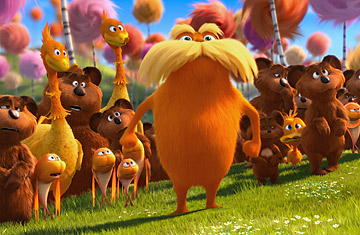
It's a Seussian riddle: what kind of SUV would the Lorax drive, if the Lorax drove an SUV? Now — thanks to Universal Pictures and its need to tie in Dr. Seuss's environmental hero to as many products as possible — we have an answer: the Mazda CX-5 compact crossover SUV. In TV ads an animated Mazda CX-5 putters through groves of Truffulas, the cotton-candy-colored trees that the Lorax speaks for in the original Dr. Seuss book. A voice-over touts the fact that the relatively fuel-efficient CX-5 is the only car to receive the "Truffula Tree Certified Seal of Approval" — which isn't that impressive considering the trees are imaginary. And then, at the end, he pops up — the Lorax, one of Dr. Seuss's most enduring characters and a founding environmental hero, here to hawk a car and a cartoon. That sound you hear is Dr. Seuss spinning like a top in his grave.
The Lorax wasn't a very good film — A.O. Scott of the New York Times called it a "noisy, useless piece of junk," and he was being nice — but that didn't matter much to audiences, who helped the movie to a record-breaking $70 million opening weekend. That's a lot of cash for a story that's supposed to be antibusiness, at least according to conservative critics like Lou Dobbs, who criticized the film for "demonizing the so-called 1% and espousing the virtue of green-energy policies." (For those who were cruelly denied Dr. Seuss as children, the original book The Lorax is an environmental parable about the Once-Ler, who ignored the Lorax's warnings and cut down all the Truffula trees to supply his growing business. It's better with his drawings.) Indeed, though the movie version of The Lorax takes significant liberties with the spare original story — the better to make spaces for the voices of actors like Zac Efron, Taylor Swift and Betty White — the kernel of environmentalism is still there for any 8-year-old viewer. Trees good, corporate greed bad.
But Universal Pictures wasn't content just to turn The Lorax into an incredibly valuable film property. The studio also inked more than 70 promotional tie-ins to the movie, with everyone from Mazda to the Environmental Protection Agency to XFinity TV. Some of those deals jibe with the green themes of the story — you wouldn't be surprised to see the Lorax endorsing the eco-cleaner Seventh Generation or the organic superstore Whole Foods. But, really, an SUV — even if it is a crossover SUV that gets 28 m.p.g. combined city and highway? Or for that matter, IHOP, now featuring Truffula chip pancakes? Or Hewlett-Packard, which promises to teach you how to "print like the Lorax," which I'm guessing is double-sided?
This isn't just a case of selling out a beloved character from children's literature. After all, Dr. Seuss himself — whose real name was Theodor Geisel — had no problem selling container ships worth of merchandise based on his work. But it goes too far when the product tie-ins directly undermine the message of the original work — and that's exactly what's happened with the film The Lorax. A story that pulses with a distrust of materialism — the very drive that causes the death of the Truffula trees — has been turned into a vehicle for selling just about anything the studio could find a buyer for.
It's natural that most of the outrage has centered on the Mazda ad, if only because SUVs have long been a rolling symbol of environmental waste and the CX-5 — even if it is a lighter crossover — isn't even a hybrid. Mazda argues that the ads still fit with the theme of The Lorax, and that its fuel-efficient SUV can actually make a bigger difference for the environment because SUVs are so much more popular than hybrid sedans. Going from a gas-guzzling SUV to a somewhat less gas-guzzling SUV in their view is a step in the right direction. "If people think that everything's going to change overnight, that's just naive," Don Romano, Mazda's chief marketing officer for North America, told NPR. "I think Dr. Seuss would be quite proud of that progress and the fact that we're taking that step."
I'm not going to presume to know Dr. Seuss's opinions — he died in 1991 — though if he were around, I can only assume he'd express them in limerick form. But the Mazda ad — and really all of The Lorax tie-ins — is an excellent example of what's known as the Prius Fallacy: the idea that choosing more environmentally benign forms of consumption means consumption itself can help save the planet. So we trade in our old truck, buy a Mazda CX-5 and pat ourselves on the back for our environmentally friendly ways. After all, now we're driving a fuel-efficient vehicle — and one that's Truffula tree–approved to boot. But if a slight improvement in miles per gallon barely makes a difference for the climate — and if the lower fuel bill prompts us to drive more — the benefit is negated altogether. As New Yorker writer David Owen put it in his recent book The Conundrum, ads like Mazda's perform the green trick of "reframing luxury consumption preferences as gifts to humanity."
Consumption can't be the answer to environmental problems because consumption ultimately is the problem. Gauzy green ads like the ones tied in to The Lorax only serve to salve our consciences while selling lots of product. The only sustainable solution to our energy-and-climate problems is to consume less — less travel, less power, less stuff. It's a prescription I suspect the real Lorax — the one who speaks for the trees, not the SUVs — could get behind, even though you can't sell a product tie-in for conservation.
